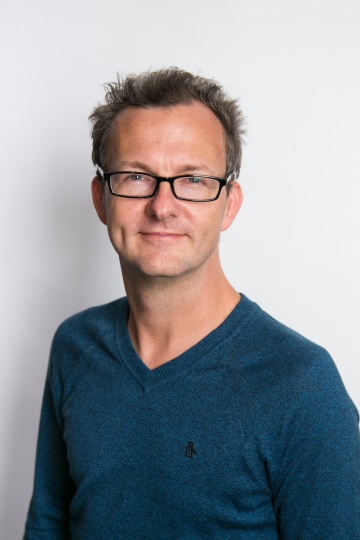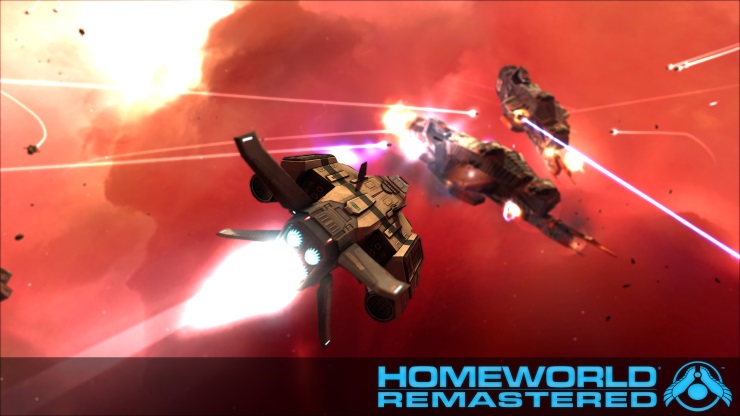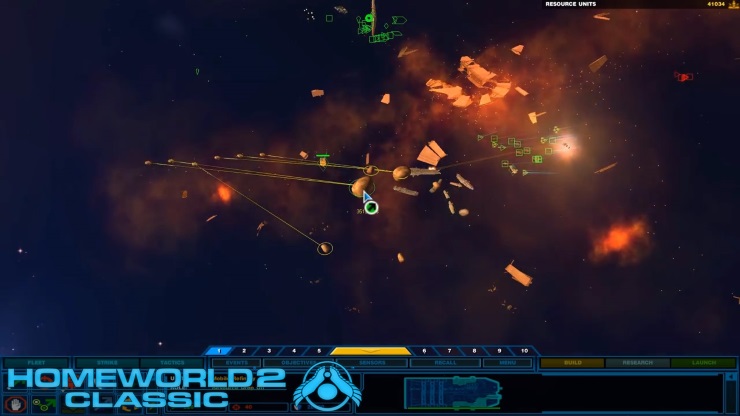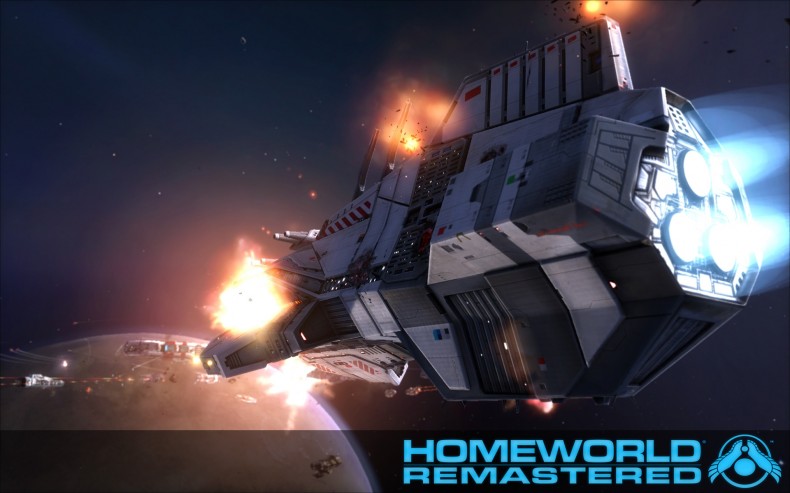The Homeworld games remain some of the best real-time strategy titles ever made, despite the original being released 16 years ago. Not only did they nail the mechanics of battling in a 3D space, where danger could come from any direction, but the art design and atmosphere they created were sublime. The sequel still ranks amongst one of my favourite games of all time.
Speaking to Gearbox’s Brian Martel and Chris Faylor, Chief Creative Officer and Product Manager respectively, it becomes clear that the Homeworld franchise means just as much to them, which Brian explains led to them purchasing the IP when THQ went bankrupt in 2013.

Brian Martel
“I think that Homeworld 1 and 2 are some of the best sci-fi that has been done in the last 16 years. I love ship design, and I loved Rob Cunningham and Aaron Kambeitz’s take on Chris Foss’ art. I just thought they were really stellar – always a good joke – just amazing ship designs. So I was always impressed with that and I was always trying to live up to that in some ways when we were doing some things for our games.
“It also had a cool place for me, because when we were founding Gearbox we were out promoting Half Life Opposing Force around the same time Relic were promoting the original Homeworld, so we’d see it at trade shows and hang out with some of the guys there, and it was always impressive. In fact there were a few game we have thought of doing over the years that were heavily influenced by Homeworld – though none have been made yet. So there is just this really cool place in my heart for these games.”
Rather than simply release them digitally however, Brian wanted to release them in a state befitting such a popular series.
“I played both of them heavily and loved them, so when the opportunity came and we bought it, I didn’t want us to just throw it out in the world as they were. I knew worst-case scenario that would be best, but I didn’t want some other company just picking it up and not treating the series with the respect that it deserves.
“When I was trying to convince my partners that this has the potential to be profitable, when we were thinking about these things, if we just put out the classics, yeah we probably would have made a little bit of money, and it would be okay, but what we really wanted to do was treat it right for the fans, and learn something from the experience remastering this, and so for us it was like: get in there and do it right, treat it like we all remember it.”
Brian is keen to stress this doesn’t mean taking the originals where he wants to, but rather to make them live up to the vision of the original creators.
“It’s not so much take it where I want to take it, that was part of the thing. I want to make sure it lives up to the vision that these guys have. One of the first things that happened to us when we bought the IP was Rob reached out to congratulate us and that action alone just kind of warmed our hearts, and we were like alright, cool, we’re in this. So we communicated back and forth, and it became evident to us that if we were going to do this and do it right we needed to incorporate as many of the original people that were involved as we could, so we’ve done a pretty good job of getting those people involved.”

“It’s one of those things that I think is really smart. If you’re going to do this kind of thing, if you can really get the guys who did it the first time, with the love and passion they had, if you can get them to feel the same way you do about it now and they’re looking at it and being impressed by it and helping out to make it what they always wanted it to look like, it’s brilliant.
“Even at the time, if you go back and look at the concept art and then look at the game, it’s not their vision. It is what they could ship, it is the limitations of the time, and we all work within the limitations of whatever engine we’re working in at the time, but for them to be able to now come back, for example Rob who did all of the backgrounds of both Homeworld 1 and 2, to come back and help art direct all of the backgrounds in both games now they’ve been uprezzed, it’s a big deal and now they can really realise their original vision.
“And that’s the thing shocking to all of us is how many people really do react and say: “That is what I remembered it like” and then you show them the original footage and they’re suddenly like: “Wow it really was kind of crappy looking” even though at the time it was stunning. It’s one of those things where you have the lens of nostalgia upon it. We’ve all done that with gaming, you look at some old game you love and it’s like: “Oh that looks terrible.”
“I think that’s kind of fun, and getting these guys involved with the cinematics and have Paul Ruskay, who was the audio director on the game, go back and find his original tapes to get some of the audio from them. All the audio, both the voice actors and the music, was all heavily compressed because it was on CD, so this is the first time you get to hear it how it originally sounded, which is pretty amazing.”
Chris agrees. Along with Paul, Gearbox have gone and found the original voice actors to re-record their parts.
“So what’s really cool is we got all of the original digital audiotapes, for everything. Back in the day this all had to be compressed to fit on a CD-rom. Not just really heavily compressed and unpacked it once it’s on installed the hard-drive, no, they made Homeworld 1 and 2 stream from the CD, because 600mb was a huge deal back then. Not only have we been able to take all of the original digital audio tapes and completely remaster the original recordings, but for Homeworld 2 we’ve re-recorded the voice for the Mothership. The voice actor for the Mothership in Homeworld 1, her name was Heidi, and when they went to record her lines for Homeworld 2, she was super pregnant. About to pop. Because of that her voice had changed a little and the recordings didn’t match up. So the team had a difficult choice and they recast a sound-alike who sounded a little bit closer, and that’s always irked some of the hard-core fans. But since we knew we were remastering 1 and 2 at the same time, we went back in and for the sake of continuity had Heidi record all of the Mothership lines in Homeworld 2.”
Rob Cunningham, along with several other former Relic members, is now at Blackbird Interactive, working on Homeworld: Shipbreakers. Blackbird tried to buy the Homeworld IP, but couldn’t afford it in the end. Brian approached them to ask if they would like to use the license.
“Around that same time, I’m not exactly sure when, this little video came out. I think it was before we got the license, and we were impressed with what these guys were doing, and thought ‘hmm that does look a lot like Homeworld.’ So when we started talking to those guys, because they had bid on the game, but it was a much lower bid and they couldn’t win it. Once we started talking to them I said: ‘You know, do you want to take Hardware and turn it into a Homeworld game?’ So that’s how that ended up happening.”
According to Chris though, there’s more to than that in the story of Shipbreakers taking the Homeworld name.
“I love Aaron’s story about that. He was Lead Artist on both Homeworld games, and he had been writing the initial pitch for Hardware: Shipbreakers. The entire time he had secretly been consulting the original Homeworld ‘bible’, without telling anybody else on the team, to make sure it still fit within the canon.
“No one else knew this on the Blackbird team, and so when Brian, came to them and said: “Hey do you guys think you could do it?” everybody else was like “Oh man, I don’t know” and Aaron was just sat at the back in the corner like: “Er guys, I got something to tell you…” So it was really funny because it was a convergence of creative passion that ultimately benefited without taking anything away from the project.”
These remasters are Gearboxes first foray into RTSs – before now the studio has almost exclusively working on FPSs. Some would expect that to be a culture shock, but Brian disagrees.
“It’s not been horrible, we’re all fans of a ton of different games and we’re the students of the industry and game mechanics in general. So it’s not like it’s that foreign a thing, and we know what good balance is and all these kinds of things. So that part of it isn’t hard, but it is new and it’s old code and we have to deal with that; having to deal with that has been a little bit of a learning curve. But we’ve found, like most of these kinds of things, that when you get a passionate team behind it and they start really caring about it, then it just rolls and it happens with the love and hard work you’d expect in a good game.”
One thing about remasters is that – while you can improve a game’s graphics to a modern standard – sometimes the gameplay itself feels out-dated, such as with the recent Grim Fandango release. This doesn’t worry Brian though.
“The thing that’s so shocking and surprising is how forward thinking these guys were, there are things that we find in the code all the time. They were at the beginning of shader tech and a few other things that were really, really smart and that when you go in and are rewriting the renderer and all that, have been really helpful.
“It’s this cool thought that “Man you guys were pretty damn smart” and I think that’s fun because Luke Moloney is doing a lot of the code work on the game, he was an original Relic guy and we’re contracting him to work on this, he’s in our studio right now, and he looks at some of this stuff and he kind of pats himself on the back and goes “Why did I do this?” and I think that’s kind of cute how those guys react to that kind of thing.

Gearbox aren’t just tuning the graphics for the remaster though. Brian says that the team has addressed some of the issues of the originals, particularly to do with pacing and bugs.
“We’ve adjusted a few of the missions, so that that they’re still true to the originals, but some of the flaws Relic always wanted to change and that they had a ton of feedback on have been tweaked a little bit, some of it has been sped up. But some of it is as it should be, it’s what the game was, the pacing of the game is the pacing of the game, but a few of the loopholes and things like that, we’ve tried to correct those, just here and there as we’ve needed.”
The team has also merged the multiplayer for both games, which has been a big task. The result, Brian says, is worth it though.
“There are several factions and a series of maps from 1v1 to 4v4, it was all over the place, but all of those maps work like they’re supposed to. The other thing we did by porting the two engines together, because the original was an earlier version of the engine, they’re two separate things, what we’ve done by bring them together, what’s really novel and cool, is to allow all of the factions from both games and all of the maps to work together. You can load them all up and destroy each other to your hearts content.”
Chris explains that they chose to merge the systems to keep the playerbase together.
“Homeworld day back in 1999, was powered by GameSpy, same with Homeworld 2 in 2003, and we knew we were going to release everything at the same time, we didn’t want to fragment the playerbase, but we also knew, because GameSpy is no more, that this was going to need all new netcode.”
When it launches, the multiplayer will have the ‘beta’ tag, because in merging the two games Chris says there’s the potential for problems. There isn’t a time-limit for the beta, work will continue until it is done.
“Those two things we just listed, the new code and having factions face off together in ways that have never been possible before are why we are calling it a beta when the multiplayer client launches.
“We’re playtesting to the best of our ability here, we’re playing hundreds and hundreds of matches, but the second we get it out in the world it’s more likely that they’ll be more matches played cumulatively in the first hour than we were able to do with our team in years.
“What’s really cool is the first time you launch it you’ll see a pop up telling you how to submit feedback, so we’re very serious about that. We want this to be a living, breathing thing, this is the grand return of Homeworld after not being available through any means than a physical CD that was printed between 15 and 12 years ago.”
One noticeable absence from the package is Cataclysm, the stand-alone expansion to the first game. As much as Gearbox would love to release it, Brian explains the why they can’t: “There are a couple of good reasons why Cataclysm isn’t included. One is that no one knows where the code is. It was a different studio that made it, Barking Dog, which later became Rockstar Vancouver. Somewhere out there it exists. If anybody out there knows where it is, and they can bring it to us we would love to do that.
“The other issue is that Blizzard bought the trademark to Cataclysm from Relic, so it would have to have the name changed. But if there were a way to get the code, we would love to at least get the classic version out. There’s a bit of a polarising quality to Cataclysm, some people loved it, some people hateit , some people think it was part of it. It was one of those things, it was done by a separate studio, not by Relic, so we felt that in the true continuity of the story having 1 and 2 at least be together as a story was really important to us.
And finally, where do you keep your Ketchup, cupboard or fridge?
Brian: “In the office? Both actually. At home, I keep mine in the fridge.”
Chris: “Me too.”
Read our hands-on preview with Homeworld Remastered.





